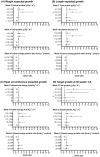Relationships between Neonatal Nutrition and Growth to 36 Weeks' Corrected Age in ELBW Babies-Secondary Cohort Analysis from the Provide Trial
- PMID: 32183057
- PMCID: PMC7146349
- DOI: 10.3390/nu12030760
Relationships between Neonatal Nutrition and Growth to 36 Weeks' Corrected Age in ELBW Babies-Secondary Cohort Analysis from the Provide Trial
Abstract
A key modifiable factor for improving neurodevelopment in extremely low birthweight (ELBW) babies may be improving growth, especially head growth, by optimising nutrition in the early neonatal period. We aimed to investigate relationships between nutrient intakes in the 4 weeks after birth, and growth from birth to 36 weeks' corrected age (CA) in ELBW babies. We undertook a prospective cohort study of 434 participants enrolled in a randomised controlled trial (ProVIDe) in eight New Zealand and Australian neonatal intensive care units. Macronutrient intakes from birth to 4 weeks and weight, length and head circumference measurements from birth to 36 weeks' CA were collected. From birth to 36 weeks' CA, the median (IQR) z-score changes were: weight -0.48 (-1.09, 0.05); length -1.16 (-1.86, -0.43), and head circumference -0.82 (-1.51, -0.19). Changes in z-score to 4 weeks and 36 weeks' CA were correlated with protein intake. Each 1 g·Kg-1·d-1 total protein intake in week 2 was associated with 0.26 z-score increase in head circumference at 36 weeks' CA. Both nutritional intake and change in z-scores to 36 weeks' CA differed widely amongst sites. Correlations between nutrition and growth, and differences in these amongst sites, indicate there may be potential to improve growth with enhanced nutrition practices.
Keywords: amino acid; extremely low birthweight; gestational age; growth; infant; newborn; nutrition; parenteral nutrition; premature; preterm; protein.
Conflict of interest statement
The authors declare no conflict of interest. The funders had no role in the design of the study; in the collection, analyses, or interpretation of data; in the writing of the manuscript, or in the decision to publish the results.
Figures







Similar articles
-
Growth and Eating Behaviours at 2 Years Corrected Age in Extremely Low-Birthweight Babies; Secondary Cohort Analysis from the ProVIDe Trial.Nutrients. 2024 Nov 27;16(23):4095. doi: 10.3390/nu16234095. Nutrients. 2024. PMID: 39683489 Free PMC article.
-
The ProVIDe study: the impact of protein intravenous nutrition on development in extremely low birthweight babies.BMC Pediatr. 2015 Aug 26;15:100. doi: 10.1186/s12887-015-0411-y. BMC Pediatr. 2015. PMID: 26307566 Free PMC article. Clinical Trial.
-
Increased protein intake decreases postnatal growth faltering in ELBW babies.Arch Dis Child Fetal Neonatal Ed. 2013 Sep;98(5):F399-404. doi: 10.1136/archdischild-2012-302868. Epub 2013 Mar 13. Arch Dis Child Fetal Neonatal Ed. 2013. PMID: 23487551
-
Practice of parenteral nutrition in VLBW and ELBW infants.World Rev Nutr Diet. 2014;110:177-89. doi: 10.1159/000358466. Epub 2014 Apr 11. World Rev Nutr Diet. 2014. PMID: 24751629 Review.
-
The Influence of Early Nutrition on Brain Growth and Neurodevelopment in Extremely Preterm Babies: A Narrative Review.Nutrients. 2019 Aug 30;11(9):2029. doi: 10.3390/nu11092029. Nutrients. 2019. PMID: 31480225 Free PMC article. Review.
Cited by
-
Growth and Eating Behaviours at 2 Years Corrected Age in Extremely Low-Birthweight Babies; Secondary Cohort Analysis from the ProVIDe Trial.Nutrients. 2024 Nov 27;16(23):4095. doi: 10.3390/nu16234095. Nutrients. 2024. PMID: 39683489 Free PMC article.
-
Transition From Parenteral to Enteral Nutrition and Postnatal Growth in Very Preterm Infants During Their First 28 Days of Life.Front Pediatr. 2022 Mar 10;10:775667. doi: 10.3389/fped.2022.775667. eCollection 2022. Front Pediatr. 2022. PMID: 35359900 Free PMC article.
-
Sex-Specific Effects of Nutritional Supplements for Infants Born Early or Small: An Individual Participant Data Meta-Analysis (ESSENCE IPD-MA) I-Cognitive Function and Metabolic Risk.Nutrients. 2022 Jan 18;14(3):418. doi: 10.3390/nu14030418. Nutrients. 2022. PMID: 35276786 Free PMC article. Review.
-
Nutrient Intake with Early Progressive Enteral Feeding and Growth of Very Low-Birth-Weight Newborns.Nutrients. 2022 Mar 11;14(6):1181. doi: 10.3390/nu14061181. Nutrients. 2022. PMID: 35334838 Free PMC article.
-
Bacteroidota and Lachnospiraceae integration into the gut microbiome at key time points in early life are linked to infant neurodevelopment.Gut Microbes. 2021 Jan-Dec;13(1):1997560. doi: 10.1080/19490976.2021.1997560. Gut Microbes. 2021. PMID: 34839801 Free PMC article.
References
-
- Ziegler E.E., O’Donnell A.M., Nelson S.E., Fomon S.J. Body composition of the reference fetus. Growth. 1976;40:329–341. - PubMed
-
- Agostoni C., Buonocore G., Carnielli V.P., De Curtis M., Darmaun D., Decsi T., Domellof M., Embleton N.D., Fusch C., Genzel-Boroviczeny O., et al. Enteral nutrient supply for preterm infants: Commentary from the European Society of Paediatric Gastroenterology, Hepatology and Nutrition Committee on Nutrition. J. Pediatr. Gastroenterol. Nutr. 2010;50:85–91. doi: 10.1097/MPG.0b013e3181adaee0. - DOI - PubMed
Publication types
MeSH terms
Grants and funding
LinkOut - more resources
Full Text Sources
Medical

